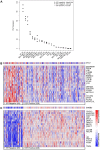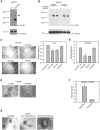PTK 7 is a transforming gene and prognostic marker for breast cancer and nodal metastasis involvement
- PMID: 24409301
- PMCID: PMC3883666
- DOI: 10.1371/journal.pone.0084472
PTK 7 is a transforming gene and prognostic marker for breast cancer and nodal metastasis involvement
Abstract
Protein Tyrosin Kinase 7 (PTK7) is upregulated in several human cancers; however, its clinical implication in breast cancer (BC) and lymph node (LN) is still unclear. In order to investigate the function of PTK7 in mediating BC cell motility and invasivity, PTK7 expression in BC cell lines was determined. PTK7 signaling in highly invasive breast cancer cells was inhibited by a dominant-negative PTK7 mutant, an antibody against the extracellular domain of PTK7, and siRNA knockdown of PTK7. This resulted in decreased motility and invasivity of BC cells. We further examined PTK7 expression in BC and LN tissue of 128 BC patients by RT-PCR and its correlation with BC related genes like HER2, HER3, PAI1, MMP1, K19, and CD44. Expression profiling in BC cell lines and primary tumors showed association of PTK7 with ER/PR/HER2-negative (TNBC-triple negative BC) cancer. Oncomine data analysis confirmed this observation and classified PTK7 in a cluster with genes associated with agressive behavior of primary BC. Furthermore PTK7 expression was significantly different with respect to tumor size (ANOVA, p = 0.033) in BC and nodal involvement (ANOVA, p = 0.007) in LN. PTK7 expression in metastatic LN was related to shorter DFS (Cox Regression, p = 0.041). Our observations confirmed the transforming potential of PTK7, as well as its involvement in motility and invasivity of BC cells. PTK7 is highly expressed in TNBC cell lines. It represents a novel prognostic marker for BC patients and has potential therapeutic significance.
Conflict of interest statement
Figures





References
-
- Ferlay SH, Bray F, Forman D, Mathers C, Parkin DM (2010) GLOBOCAN 2008 v1.2, Cancer Incidence and Mortality Worldwide: IARC CancerBase No. 10 [Internet]. Lyon, France: International Agency for Research on Cancer; 2010. Available: http://globocan.iarc.fr. Accessed 2013 Apr 17.
-
- Bundred NJ (2001) Prognostic and predictive factors in breast cancer. Cancer Treat Rev 27: 137–142. - PubMed
-
- Mossie K, Jallal B, Alves F, Sures I, Plowman GD, et al. (1995) Colon carcinoma kinase-4 defines a new subclass of the receptor tyrosine kinase family. Oncogene 11: 2179–2184. - PubMed
-
- Park SK, Lee HS, Lee ST (1996) Characterization of the human full-length PTK7 cDNA encoding a receptor protein tyrosine kinase-like molecule closely related to chick KLG. Journal of biochemistry 119: 235–239. - PubMed
Publication types
MeSH terms
Substances
LinkOut - more resources
Full Text Sources
Other Literature Sources
Medical
Research Materials
Miscellaneous

